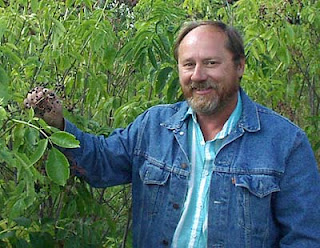The dance of the seasons continues…
The dance of the seasons 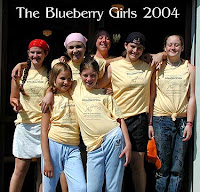 continues, and snow is on the ground in northern Vermont. At the end of this growing season, I think about what great grandfather Thomas told us as he reflected on his life as a farmer, “The best fertilizer is always the imprint of the owner’s feet.” There are so many feet that have made our work possible this season; thank you so much.
continues, and snow is on the ground in northern Vermont. At the end of this growing season, I think about what great grandfather Thomas told us as he reflected on his life as a farmer, “The best fertilizer is always the imprint of the owner’s feet.” There are so many feet that have made our work possible this season; thank you so much.
We have moved through the months of harvesting, and our Apitherapy honey is in jars throughout the honey house, all naturally crystallized and reflecting the different flowers in each one. Buckets of organic elderberry and organic blueberries are in the freezer and leave every month to make our line of plant medicine. Dried purple loosestrife sit in glass jars in dark, protected places, resting in their purple majesty of pure plant medicine. Bags of pumpkin seeds wait for the final cleaning before being ground into oil.
The honey harvest was medium plus; much came in the eleventh hour, testing our patience and trust. We are grateful that our sustainability and continuity is not pegged to the amount of the honey crop any more because of our diversification further into plant medicine. What springs from the earth is what we are given, and for this we are grateful. It is exciting to have our Apitherapy honey elderberry extract available in this cold season and at time where one’s immunity can be supported when the flu comes. It is ironic that with all of the talk about the shortage of the flu vaccine, there is a traditional elderberrythat works so well. Elderberry has the anti-viral agent not found in chemical cold & flu medicines. The new 8 oz. value bottles have been discovered and are moving into the market, thanks to you all.
The tough news is that the honey bees are continuing to decline world wide, as they are affected by the parasitic mites, the poor quality of air and our land, and a lost of flowers due to development of buildings and structures. Our friend who took off a season from our honey house to work with bees in Montana reports that populations of bees reports widespread decrease of bees all over the West and a shortage of colonies for bees to pollinate the almonds. The populations of our own bees are crashing in many places, and many will have to go to South Carolina for a more gentle winter and re-build their families in the early Spring there to return to their home in the Champlain Valley of Vermont and St. Lawrence River Valley of northern New York State where the crops are.
Because almost 40% of what we eat dependent on insects (primarily honey bees) for pollination, this is of concern. Most of the wild bees have already died.
research
Raw honey has been shown to inhibit the growth of pathogens in food and food spoilage organisms. Scientists at Cornell University, Geneva, New York report “Honey has been used as a topical and gastrointestinal remedy for thousands of years, and has recently gained recognition from the medical field. The growth of many microorganisms associated with disease or infection is inhibited by honey.” more, full abstract from International Journal of Food Microbiology.
It is exciting that raw honey is now getting this kind of through review from the scientific community; we are so thankful to two of the authors of this article for help in the development of our blueberry Rejuvenation Tonic and for monitoring our product for shelf life stability.
candlelight
 As we move towards winter and the solstice, we offer our pure lemon yellow beeswax candles and beeswax for your own candle making. The beeswax from the bees and flowers burns pure and actually changes the charges on ions in the air, similar to what happens when you stand next to a waterfall or take a shower. People report this cleaner air helps with their allergies and sinus conditions. Burning a paraffin candles in your home is like burning a old tire in your living room;it is not safe.
As we move towards winter and the solstice, we offer our pure lemon yellow beeswax candles and beeswax for your own candle making. The beeswax from the bees and flowers burns pure and actually changes the charges on ions in the air, similar to what happens when you stand next to a waterfall or take a shower. People report this cleaner air helps with their allergies and sinus conditions. Burning a paraffin candles in your home is like burning a old tire in your living room;it is not safe.
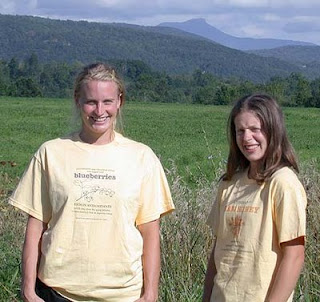
education/T-shirts
To share more about elderberries, blueberries, purple loosestrife, and raw honey, we made some cotton T-shirts.
This picture of Abigail and Margaret was taken at the honey house in late August, with Camel’s Hump, 4th highest peak in Vermont, in the background. more
pumpkin seeds for oil

We planted several acres of Stryian pumpkins this summer, seeking to learn more about the historical uses of plants as medicine for people. This plant ally is traditionally grown in the Styria region of Austria and produces oil called “the green gold of Styria”; it is a rich, dark green color due to the high levels of chlorophyll, anti-oxidative substances and unsaturated fatty acids. The oil also contains many important minerals including magnesium, silica, and calcium as well as essential vitamins.This medicinal plant supports cardiovascular health, aid in urinary well being and has been known to helps support urinary well being, cardiovascular and prostate health. by Abigail Burns
www.hgfarmersmarket.com
a new sister website offering organic Maine dulse from Larch and fresh pollen from Paul’s honey bees in the highlands of Colorado
In time, we saw that the exclusive production of honey was not sustainable. As special as truly raw honey is, beekeeping is extremely labor intensive, and along with the fluctuations of crops each year, the pressure that the bees are feeling from the parasitic mites worldwide and deterioration of the environment and flowers, and loss of nectar and pollen plants to development, we had to diversify to continue in agriculture. A string of partnerships with people began as we grew our line of plant medicine, mixing organic and wild crafted plants with raw honey, bee gathered propolis & flower pollen, and beeswax. We now support other family farms that grow and gather some of the natural raw materials that we use, such as organic elderberry, blueberry, calendula, seaweed, and propolis.
Our support of organic farmers and the web of these growing relationships has revealed that many of these farmers would benefit from an introduction to the market and community that supports Honey Gardens. Certainly our relationships have grown because of the internet connections which allow us to move towards sustainability in our work.
As Honey Gardens started and continues to remain a family business, the sharing of our friends’ work will start small and embody the same standards of being simple, genuine and true. We have come to love Theresa and her family that grow our organic blueberries and share their excitement as their crop moves from beyond the fresh and frozen arena into a medicinal use. It is an honor to support Larch’s work off the Atlantic coast of Maine as he gathers the seaweed that we use in our Rejuvenation Tonic and facial masque and now offer to you for your meals and healthy snacks. Over 20 years ago, I traveled to the highlands above the Colorado River with Paul and we worked with his bees in sacred meadows, harvesting the fresh pollen that we now use in our line and want to share with others through this farmers market.
For all of the feet in the field to the market, we thank you for your interest in and support of these people, plants and the work of the bees.
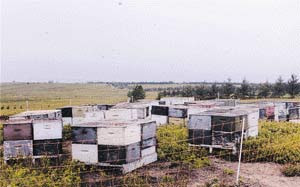
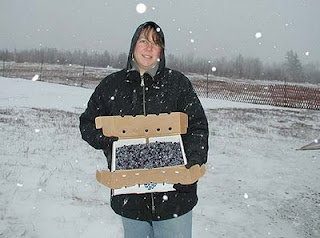
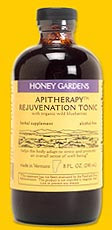 After months of working together with a team from the honey house, Cornell University, Geneva, NY, the University of Vermont, the Vermont Food Venture Center, and the University of Maine, we have made Rejuvenation Tonic. With organic wild blueberries from Theresa and Tom Gaffney’s organic blueberry farm in Stockton Springs, Maine, this tonic will nutrify and support our bodies well being via the vitamin and mineral content and enzymes of its ingredients. Rejuvenation Tonic will help the body adapt to stress and promote an overall sense of well-being.
After months of working together with a team from the honey house, Cornell University, Geneva, NY, the University of Vermont, the Vermont Food Venture Center, and the University of Maine, we have made Rejuvenation Tonic. With organic wild blueberries from Theresa and Tom Gaffney’s organic blueberry farm in Stockton Springs, Maine, this tonic will nutrify and support our bodies well being via the vitamin and mineral content and enzymes of its ingredients. Rejuvenation Tonic will help the body adapt to stress and promote an overall sense of well-being.
